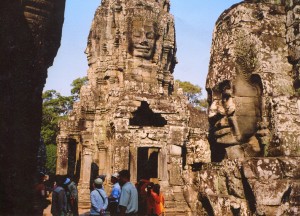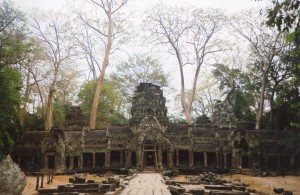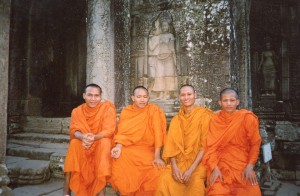In the 30 years after Angkor Wat was built, Angkor was plagued by royal succession crises and an invasion by a powerful federation of cities called the Chams (from Vietnam). But Jayavarman VII took the throne in 1181, extended the empire, and built more grandly than any Khmer king did. Many people consider his constructions to represent Angkor in its glory days. They sure wowed me.
Angkor during this time had manycultural currents, as its European contemporaries who built the great Gothic cathedrals did. Both societies together make a very cool comparative study. We’ll compare some of the greatest monuments from both cultures over the next few days, and we’ll make some flights to other lands in between–fasten your seatbelts. But first, we’ll meet the man who spearheaded Angkor’s greatest glories.
That’s Jayavarman’s cult temple (the Bayon) in the above photo. It’s gentle and monumental at the same time because Jayavarman VII reigned in a time and place with many personalities.
1. David Chandler wrote that Jayavarman probably served at the court of a king called Yasovarman II. But Yasovarman was murdered in the 1160’s.
2. Chandler wrote that Jayavarman probably lived away from Angkor from 1166 to 1177. The Chams invaded Angkor in 1177. Jayavrman campaigned against them, and defeated them in a naval battle in 1178. He was crowned king in 1181, and he initiated massive changes in Angkor which propelled it into many of its greatest creations.
3. Jayavarman became a Mahayana Buddhist. This was a dramatic break with tradition. Prior Khmer kings were Hindus. Most honored Shiva in their royal cult temple. Indravarman established this as the Khmer tradition at the Bakong. The builder of Angkor Wat, Suryavarman II, turned from that tradition by following Vishnu. But Jayavarman changed the Khmer religious landscape more radically by becoming a Buddhist.
4. France’s King Philippe Auguste took the French throne in 1180–just a year before Jayavarman VII did. Both reigns have common features. Philippe Auguste also centralized the state while fighting bitter wars with a strong foe (England), and he presided over great religious constructions (classic Gothic cathedrals like Chartres and Bourges). But Jayavarman changed his society more radically–no European king could have changed his religion from the Christian faith. The Khmer king had more freedom to introduce new ideas into his society, and he mixed them with some of the traditions that earlier kings sponsored. As we’ll see in the next post on Jayavarman, Angkor in its glory days was a different society than Europe, and just as interesting.




Comments on this entry are closed.